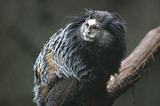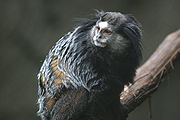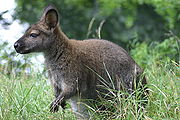
Blank Park Zoo
Encyclopedia
Blank Park Zoo is a zoo
on the south side of Des Moines, Iowa
near Fort Des Moines
.
Over the next 16 years the city failed to make improvements to the zoo and was on the verge of closing until in 1981 a group of civic minded business leaders formed the Blank Park Zoo Foundation to help save the zoo. The Foundations number one goal was to provide financial support for capital improvements, animal acquisitions and promotional and marketing activities.
The Foundation succeeded by forming a partnership with the City of Des Moines that resulted in a $1.8 million dollar bond referendum, as well as an additional $1.4 million dollars from the community. Finally at the end of 1982 the zoo closed for some much needed renovations.
accredited zoo. The renovated Zoo had a new mission of conservation, education and recreation, and featured geographic themed exhibits with spacious, naturally landscaped environments. In 1995 the Blank Park Zoo Foundation purchased 25.3 acres (102,385.6 m²) additional of historic Fort Des Moines property and 9 historic buildings for future growth and expansion of the Zoo. It also began a capital campaign to build a new great cats exhibit and a 30000 square feet (2,787.1 m²) indoor Discovery Center exhibit. On May 1, 1999 the Tom and Jo Ghrist Great Cats exhibit opened and on September 1, 2001, the Blank Park Zoo opened the Myron & Jackie Blank Discovery Center which has become a popular year round attraction. On July 1, 2003 the Blank Park Zoo Foundation officially accepted all responsibility of the management and operations of the zoo from the City of Des Moines. In October 2003 the first Zoo CEO, Terry Rich, was hired and has opened the door to further growth and development, and on May 8, 2006 the zoo successfully celebrated 40 years.
 The Discovery Center is an entirely enclosed area you encounter first when you enter the zoo and contains many different types of animal and plant life. The Discovery Center itself is broken down into separate sections to create a unique viewing experience:
The Discovery Center is an entirely enclosed area you encounter first when you enter the zoo and contains many different types of animal and plant life. The Discovery Center itself is broken down into separate sections to create a unique viewing experience:

In 2005 the Conservation Committee chose to participate in 4 programs:
Zoo
A zoological garden, zoological park, menagerie, or zoo is a facility in which animals are confined within enclosures, displayed to the public, and in which they may also be bred....
on the south side of Des Moines, Iowa
Des Moines, Iowa
Des Moines is the capital and the most populous city in the US state of Iowa. It is also the county seat of Polk County. A small portion of the city extends into Warren County. It was incorporated on September 22, 1851, as Fort Des Moines which was shortened to "Des Moines" in 1857...
near Fort Des Moines
Fort Des Moines
Fort Des Moines can refer to:*Fort Des Moines No. 1 , a U.S. Army post that grew into Montrose, Iowa*Fort Des Moines No. 2 , a U.S. Army post that grew into Des Moines, Iowa...
.
Early years
In 1963, Mr. A.H. Blank donated $150,000 ($916,000 in 2005 dollars) for the construction of a children's zoo on decommissioned Fort Des Moines property. The Des Moines Children’s Zoo was officially opened on May 8, 1966. It was originally designed around nursery rhymes and included a castle with moat, a replica of Noah's Ark, petting zoo and miniature railroad.Over the next 16 years the city failed to make improvements to the zoo and was on the verge of closing until in 1981 a group of civic minded business leaders formed the Blank Park Zoo Foundation to help save the zoo. The Foundations number one goal was to provide financial support for capital improvements, animal acquisitions and promotional and marketing activities.
The Foundation succeeded by forming a partnership with the City of Des Moines that resulted in a $1.8 million dollar bond referendum, as well as an additional $1.4 million dollars from the community. Finally at the end of 1982 the zoo closed for some much needed renovations.
Post renovation
On May 17, 1986 the new and improved Blank Park Zoo reopened, and officially became an AZAAssociation of Zoos and Aquariums
The Association of Zoos and Aquariums was founded in 1924 and is a nonprofit organization dedicated to the advancement of zoos and public aquariums in the areas of conservation, education, science, and recreation.The AZA headquarters is located in Silver...
accredited zoo. The renovated Zoo had a new mission of conservation, education and recreation, and featured geographic themed exhibits with spacious, naturally landscaped environments. In 1995 the Blank Park Zoo Foundation purchased 25.3 acres (102,385.6 m²) additional of historic Fort Des Moines property and 9 historic buildings for future growth and expansion of the Zoo. It also began a capital campaign to build a new great cats exhibit and a 30000 square feet (2,787.1 m²) indoor Discovery Center exhibit. On May 1, 1999 the Tom and Jo Ghrist Great Cats exhibit opened and on September 1, 2001, the Blank Park Zoo opened the Myron & Jackie Blank Discovery Center which has become a popular year round attraction. On July 1, 2003 the Blank Park Zoo Foundation officially accepted all responsibility of the management and operations of the zoo from the City of Des Moines. In October 2003 the first Zoo CEO, Terry Rich, was hired and has opened the door to further growth and development, and on May 8, 2006 the zoo successfully celebrated 40 years.
Future plans
On December 15, 2006, Blank Park CEO Terry Rich unveiled a huge expansion plan to the county planning board that would require help from 12 local entities to complete. One huge stumbling block however is the estimated $50 million dollar price tag. The completed expansion would include:- An expanded world class “modern” zoo to include updating the current zoo and adding additional land for new exhibits.
- Establishing a “conservation/education” headquarters for K-12 students and early childhood organizations which would also educate the public about the historic values of Fort Des Moines.
- Designate county park preserve, wetland preserve, and a new neighborhood playscape park.
- A partnership with south side businesses, including Southridge MallSouthridge Mall (Iowa)Southridge Mall is an enclosed regional shopping mall on the south side of Des Moines, Iowa. It attracts roughly 3.3 million visitors per year, with a primary trade area consisting of most of the city of Des Moines and areas to its south and east....
, to revitalize southern Polk County’s economic development. - A partnership with the Des Moines School DistrictDes Moines Public SchoolsThe Des Moines Public Schools is the largest public school district in Iowa...
to include relocation of the Central CampusCentral Academy (Des Moines)Central Academy is a public magnet school located at 1912 Grand Avenue in Des Moines, Iowa for students between grades 6 and 12. Commissioned by the Des Moines Public Schools in 1985, the Academy has played host to some of the brightest minds in the state. The school is nationally recognized for...
Marine Biology program and a diving pool for Iowa’s EMT and Police departments. - Establishment of an international festival grounds for state-wide events.
- Historic living area to include a grand entrance and bandshell.
- The south side bike trail and a trail hub for southern Polk County.
- An endangered species conservation facility.
Discovery Center

The Cave
- Madagascar hissing cockroachMadagascar hissing cockroachThe Madagascar hissing Cockroach , also known as the Hissing Cockroach or simply Hisser, is one of the largest species of cockroach, reaching 2–4 inches at maturity. They are from the island of Madagascar off the African coast, where they can be found in rotting logs.Unlike most cockroaches, they...
(Gromphadorhina portentosa) - Emperor scorpionEmperor scorpionThe emperor scorpion, Pandinus imperator, is a species of scorpion native to Africa. It is one of the largest scorpions in the world and lives for 5–8 years. Its body is black, but glows under ultraviolet light...
(Pandinus imperator) - House cricketHouse cricketAcheta domesticus, commonly called the house cricket, is a cricket most likely native to Southwestern Asia, but has spread worldwide...
(Acheta domesticus)
Bat Cave
- Egyptian Fruit BatEgyptian fruit batThe Egyptian Fruit Bat or Egyptian Rousette is a species of Old World fruit bat found throughout Africa, except in the desert regions of the Sahara, and throughout the Middle East, as far east as Pakistan and northern India...
(Rousettus aegyptiacus) - Greater Flying Fox (Pteropus vampyrus)
Amazon Pool
- Red Bellied PacuRed bellied pacuThe red bellied pacu, Colossoma bidens, is a close relative of the piranha, but it lacks sharp teeth and is not aggressive. The pacu, an omnivore, has jaws that are capable of crushing human bone. Despite its similar appearance to piranhas, the Pacu is not suited to eat meat very well, as its...
(Colossoma brachypomus) - Redtail catfishRedtail catfishThe redtail catfish, Phractocephalus hemioliopterus, is a pimelodid catfish named for its red or orange caudal fin. In Venezuela it is known as cajaro and in Brazil and even in a few parts of Bay of Bengal it is known as pirarara. It is the only extant species of the genus Phractocephalus. This...
(Phractocephalus hemioliopterus) - Red-bellied piranhaRed-bellied piranha-Diet:Their diet consists largely of fish, insects, worms, crustaceans, and the occasional larger animal. In contrast to their reputation, they usually feed on dead, dying, and injured vertebrates in the wild, but have been known to attack healthy animals. The fish usually feed in large schools...
(Pygocentrus nattereri)
Australian Trail

- Red-necked WallabyRed-necked WallabyThe Red-necked Wallaby is a medium-sized marsupial macropod, common in the more temperate and fertile parts of eastern Australia, including Tasmania.- Description :...
{Macropus rufogriseus) - EmuEmuThe Emu Dromaius novaehollandiae) is the largest bird native to Australia and the only extant member of the genus Dromaius. It is the second-largest extant bird in the world by height, after its ratite relative, the ostrich. There are three subspecies of Emus in Australia...
(Dromaius novaehollandiae) - Giant KingfisherGiant KingfisherThe Giant Kingfisher is the largest kingfisher in Africa, where it is a resident breeding bird over most of the continent south of the Sahara Desert other than the arid southwest....
(Megaceryle maxima) - Cattle EgretCattle EgretThe Cattle Egret is a cosmopolitan species of heron found in the tropics, subtropics and warm temperate zones. It is the only member of the monotypic genus Bubulcus, although some authorities regard its two subspecies as full species, the Western Cattle Egret and the Eastern Cattle Egret...
(Bubulcus ibis) - Brown QuailBrown QuailThe Brown Quail , also known as Swamp Quail, is an Australasian true quail of the family Phasianidae.The Brown Quail is distributed in agricultural areas, wet grasslands, shrublands and freshwater wetlands across much of New Guinea and the Lesser Sunda Islands as well as in northern, eastern,...
(Coturnix ypsilophora)
Contact Area
- Trumpeter swanTrumpeter SwanThe Trumpeter Swan, Cygnus buccinator, is the largest native North American bird, if measured in terms of weight and length, and is the largest living waterfowl species on earth. It is the North American counterpart of the European Whooper Swan.-Description:Males typically measure from and weigh...
(Cygnus buccinator) - LlamaLlamaThe llama is a South American camelid, widely used as a meat and pack animal by Andean cultures since pre-Hispanic times....
- GoatGoatThe domestic goat is a subspecies of goat domesticated from the wild goat of southwest Asia and Eastern Europe. The goat is a member of the Bovidae family and is closely related to the sheep as both are in the goat-antelope subfamily Caprinae. There are over three hundred distinct breeds of...
- KoiKoior more specifically , are ornamental varieties of domesticated common carp that are kept for decorative purposes in outdoor koi ponds or water gardens....
- Holstein cattle
Great Cats
- ServalServalThe serval , Leptailurus serval or Caracal serval, known in Afrikaans as Tierboskat, "tiger-forest-cat", is a medium-sized African wild cat. DNA studies have shown that the serval is closely related to the African golden cat and the caracal...
(Leptailurus serval) - LionLionThe lion is one of the four big cats in the genus Panthera, and a member of the family Felidae. With some males exceeding 250 kg in weight, it is the second-largest living cat after the tiger...
(Panthera leo} - Snow leopardSnow LeopardThe snow leopard is a moderately large cat native to the mountain ranges of South Asia and Central Asia...
(Uncia uncia) - Siberian Tiger (Panthera tigris altaica)
- CaracalCaracalThe caracal is a fiercely territorial medium-sized cat ranging over Western Asia, South Asia and Africa.The word caracal comes from the Turkish word "karakulak", meaning "black ear". In North India and Pakistan, the caracal is locally known as syahgosh or shyahgosh, which is a Persian term...
(Caracal caracal)
Marine Animals
- Harbor sealHarbor SealThe harbor seal , also known as the common seal, is a true seal found along temperate and Arctic marine coastlines of the Northern Hemisphere...
(Phoca vitulina) - California Sea LionCalifornia Sea LionThe California sea lion is a coastal sea lion of western North America. Their numbers are abundant , and the population continues to expand about 5% annually. They are quite intelligent and can adapt to man-made environments...
(Zalophus californianus) - Magellan Penguin (Spheniscus magellanicus)
- WalrusWalrusThe walrus is a large flippered marine mammal with a discontinuous circumpolar distribution in the Arctic Ocean and sub-Arctic seas of the Northern Hemisphere. The walrus is the only living species in the Odobenidae family and Odobenus genus. It is subdivided into three subspecies: the Atlantic...
(Odobenus rosmarus)
African Section
- Reticulated Giraffe (Giraffa camelopardalis reticulata)
- Bongo (antelope)Bongo (antelope)The western or lowland bongo, Tragelaphus eurycerus eurycerus, is a herbivorous, mostly nocturnal forest ungulate and among the largest of the African forest antelope species....
(Tragelaphus eurycerus) - ZebraZebraZebras are several species of African equids united by their distinctive black and white stripes. Their stripes come in different patterns unique to each individual. They are generally social animals that live in small harems to large herds...
- GerenukGerenukThe Gerenuk , also known as the Waller's Gazelle, is a long-necked species of antelope found in dry bushy scrub and steppe in East Africa, from Somalia and eastern Ethiopia through northern and eastern Kenya to northeastern Tanzania...
(Litocranius walleri)
American Bald Eagles
In June 2007, the Blank Park Zoo added the William C Knapp Family American Bald Eagle Exhibit. The birds are a pair from the Maryland Zoo in Baltimore. The birds are so called "rehab" birds that were injured in the wild and rescued, but they couldn't make it on their own in the wild. According to the rules of keeping Bald Eagles, all feathers shed by the birds must be collected and sent to a place that distributes them to Native Americans.Kids' Kingdom
In late June 2007, the Zoo, The Greater Des Moines Leadership Institute and hundreds of volunteers around Des Moines built the new Kids' Kingdom playground. It includes 5600 sq ft (520.3 m²) of slides, mazes, monkey bars, sand pits, fossil digs and more. The Kids' Kingdom area also includes many for "contact animals" which includes, sheep, goats, llamas, miniature donkeys, koi fish, and a Zebu. Another fun new attraction is the mining sluice.Conservation programs
Starting in 1997, The Blank Park Zoo Conservation Committee has raised funds for a wide variety of worldwide conservation projects. The primary projects of the Committee must be international, must focus on protecting animals or their natural ecosystems, and must also have some tie to the Blank Park Zoo. Money is collected through various means such as children's face painting, special event raffles, and coin donation buckets.In 2005 the Conservation Committee chose to participate in 4 programs:
- The International Snow Leopard Trust - to protect the natural habitat of snow leopards
- Hornbill Nest Protection - to prevent illegal poaching of hornbills
- The Great Ape TrustGreat Ape TrustThe Great Ape Trust is a ape sanctuary and language study in Des Moines, Iowa, that houses orangutans and bonobos. The sanctuary opened to primates on September 28, 2004. The mission of the Great Ape Trust is studying language, culture, intelligence, and tool use in primates...
- aimed to rescue orangutans and bonobos in areas of deforestation and poaching - Panamanian Golden Frogs - aimed to sponsor a program to release captive frogs into the wild

